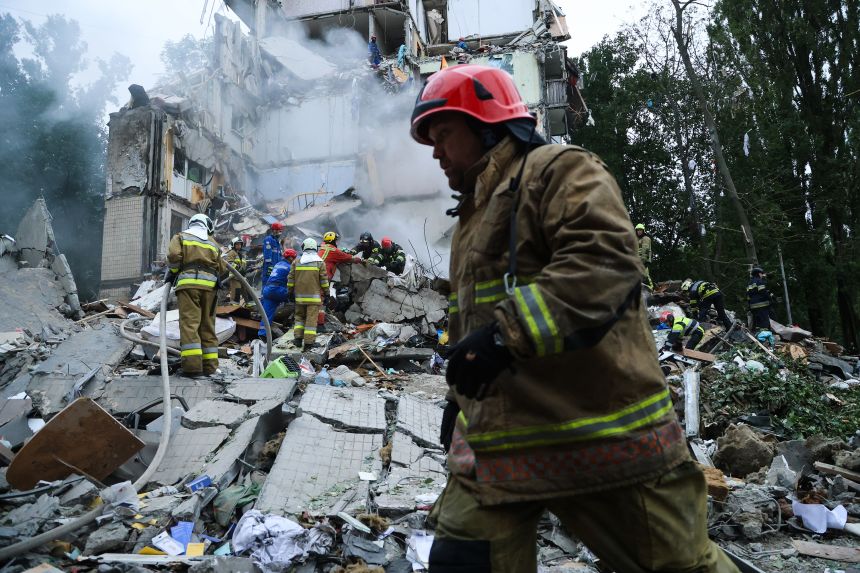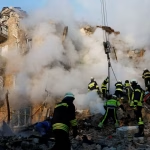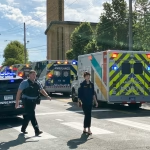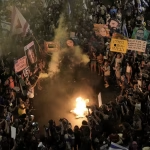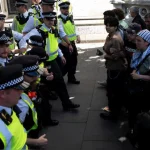The people of Kyiv woke up to terrifying scenes as Russia launched its heaviest bombardment in weeks, shattering a fragile sense of normalcy in Ukraine’s capital. Explosions lit up the sky, homes and offices rattled, and underground shelters filled once again with frightened families. For many Ukrainians, the attack was a grim reminder that the war—now dragging well into its second year—remains far from over.
- A Morning of Fear and Devastation
- The Scale of the Attack
- Experts believe this bombardment was aimed at:
- Human Stories Amid the Chaos
- Kyiv’s Resilience in the Face of Aggression
- International Reactions
- Economic Fallout and Civilian Hardship
- The Broader Military Context
- Psychological Impact on Residents
- The Role of Civil Defense and Shelters
- What Lies Ahead for Kyiv
- FAQs
- How many people were killed in the latest Kyiv bombardment?
- Why did Russia escalate attacks on Kyiv?
- How are Kyiv residents coping with the bombardment?
- What is the international response to the attack?
- Could the attacks worsen this winter?
- How effective are Ukraine’s air defenses?
- Will Kyiv remain a target?
- Conclusion
This article explores the events of the latest bombardment, its human and geopolitical impact, expert reactions, and what it means for the future of Ukraine.
A Morning of Fear and Devastation
Just after dawn, Kyiv’s air raid sirens screamed across the city. Within minutes, loud blasts shook neighborhoods from the historic city center to the outer districts. According to Ukrainian authorities, Russia fired a combination of cruise missiles, drones, and artillery in a wave of attacks designed to overwhelm Kyiv’s air defenses.
Residents described the morning as one of the most intense in recent memory. Glass shattered from apartment windows, debris scattered across streets, and fires broke out in several residential and industrial areas. Emergency services scrambled to rescue people trapped under rubble.
For families who had started to regain a semblance of routine—sending children to school, reopening shops, or even attending small social gatherings—the bombardment was a brutal setback. “We thought we had adapted to this war, but this morning reminded us how fragile everything is,” said Oksana, a mother of two who spent hours in a crowded basement shelter.
The Scale of the Attack
Ukrainian officials confirmed that it was the heaviest bombardment Kyiv had experienced in weeks. Initial reports indicated:
Over 40 missiles and drones were launched at Kyiv and its surroundings.
More than a dozen were intercepted by air defense systems, but several got through.
At least 18 people were killed and more than 60 injured, according to hospital figures.
Residential areas, a power substation, and public infrastructure were among the targets.
The attack also caused widespread blackouts in some neighborhoods, forcing thousands to rely on backup generators. Public transportation was temporarily halted, with metro stations once again doubling as bomb shelters.
Russia’s Strategy Behind the Escalation
Analysts say the attack was not random. Moscow has intensified strikes on Ukrainian cities whenever there are signs of progress in Kyiv’s military or diplomatic efforts.
Experts believe this bombardment was aimed at:
Weakening civilian morale – By targeting the capital, Russia hopes to break public spirit.
Straining air defenses – Continuous drone and missile attacks stretch Ukraine’s resources.
Sending a political message – The strike comes amid renewed Western discussions of aid packages and weapons deliveries.
“Russia wants to show it can still strike at the heart of Ukraine,” said a European defense analyst. “These attacks are less about military advantage and more about psychological warfare.”
Human Stories Amid the Chaos
Numbers and statistics only tell part of the story. What remains etched in memory are the human faces behind the destruction.
An elderly couple lost their home in Obolon district when a missile struck nearby, reducing their modest apartment to rubble. Neighbors carried them to safety.
A school in central Kyiv was hit by falling debris. Fortunately, students had been evacuated to a shelter, but the playground now lies in ruins.
Healthcare workers in Kyiv hospitals treated dozens of wounded, working around the clock despite power outages and dwindling medical supplies.
“My daughter cried the entire morning. She’s only seven, and she keeps asking me why the bombs keep coming back,” said a young father. “What do you tell a child in moments like this?”
Kyiv’s Resilience in the Face of Aggression
Despite the devastation, Kyiv once again demonstrated resilience. Within hours of the attack, residents were seen clearing debris, repairing windows, and checking on neighbors. Restaurants offered free meals to families whose homes were damaged, and volunteers delivered blankets and water to shelters.
The Ukrainian government praised the bravery of emergency workers who risked their lives to rescue survivors. President Volodymyr Zelensky vowed that the attack would not break Ukraine’s spirit, declaring: “Kyiv stands, and Ukraine stands. No missile will make us surrender.”
The bombardment has also sparked renewed solidarity among Ukrainians abroad. Diaspora communities organized vigils and fundraisers within hours of the news spreading, reinforcing the sense of unity against Russian aggression.
International Reactions
The international community responded swiftly to the latest assault.
Western leaders condemned the strikes, with some calling them deliberate war crimes against civilians.
European Union officials pledged to accelerate the delivery of air defense systems to Ukraine.
The United States reaffirmed its military and humanitarian support, noting that the attacks underscore the need for continued assistance.
Even countries that have tried to remain neutral expressed concern about the scale of the bombardment. Human rights organizations urged investigations into potential violations of international law.
Economic Fallout and Civilian Hardship
Beyond immediate destruction, the bombardment deepened Ukraine’s economic struggles. Power outages disrupted businesses, supply chains were delayed, and public transport faced interruptions.
Experts warn that repeated attacks on infrastructure could slow Kyiv’s already fragile economic recovery. Winter remains a looming concern—if power plants and energy facilities continue to be targeted, millions of residents could face severe shortages of heat and electricity.
Local shopkeepers expressed fear that customers may stay home more often, reducing incomes. Small businesses, which have kept the city alive, may find it increasingly difficult to survive under constant threat.
The Broader Military Context
This bombardment comes amid shifting dynamics on the battlefield. Ukrainian forces have been trying to push back Russian advances in the east and south, while lobbying Western allies for more advanced weapons.
Analysts suggest the attack on Kyiv was meant to divert attention and resources away from frontlines. By forcing Ukraine to defend its capital, Russia hopes to stretch Ukrainian forces thinner across multiple fronts.
However, Ukraine’s growing arsenal of Western-supplied air defense systems has limited the damage compared to earlier waves of strikes. Interception rates remain high, though gaps still exist.
Psychological Impact on Residents
The bombardment has renewed fears of long-term psychological trauma among Kyiv’s population. Psychologists warn that repeated exposure to sirens, explosions, and displacement can lead to widespread post-traumatic stress disorder (PTSD), particularly among children.
Studies show that nearly 70% of Ukrainian children living in war zones report symptoms of anxiety and depression. For parents, the pressure of ensuring safety while maintaining daily routines has become unbearable.
“Every time the sirens go off, I feel my heart stop,” said a Kyiv schoolteacher. “We tell the children it’s just a drill, but they know the truth.”
The Role of Civil Defense and Shelters
Kyiv’s network of underground shelters, including metro stations, once again proved lifesaving. Thousands sought refuge during the attack, some staying overnight. Authorities credited improved shelter coordination for preventing higher casualties.
However, many residents complained that shelters remain overcrowded and under-equipped. There are calls for more investment in civil defense infrastructure to prepare for future strikes.
What Lies Ahead for Kyiv
The latest bombardment raises critical questions about the trajectory of the war. Will Russia intensify its strikes further? Can Ukraine’s allies provide enough support to shield its capital?
Analysts suggest that as long as the war drags on, Kyiv will remain a symbolic and strategic target. But the resilience of its people, combined with international backing, could prevent Moscow from achieving its goals.
For Kyiv residents, the path forward is uncertain. Yet the determination to rebuild, resist, and survive remains unshaken.
FAQs
How many people were killed in the latest Kyiv bombardment?
At least 18 people lost their lives, and more than 60 were injured in the attack, according to Ukrainian hospital figures.
Why did Russia escalate attacks on Kyiv?
Experts believe the strikes were aimed at undermining civilian morale, straining air defenses, and sending a political message to Ukraine’s Western allies.
How are Kyiv residents coping with the bombardment?
Despite fear and destruction, residents are showing resilience—repairing homes, volunteering in shelters, and supporting each other.
What is the international response to the attack?
Western leaders condemned the strikes, calling for increased aid to Ukraine. Human rights groups are urging investigations into possible war crimes.
Could the attacks worsen this winter?
Yes. Analysts warn that if Russia continues targeting energy infrastructure, millions of Ukrainians could face severe power and heating shortages.
How effective are Ukraine’s air defenses?
Ukraine has intercepted many incoming missiles and drones, but some still penetrate defenses, causing casualties and damage.
Will Kyiv remain a target?
Most experts agree that Kyiv will continue to face bombardments as long as the war persists, given its symbolic and strategic importance.
Conclusion
The heaviest bombardment in weeks has left Kyiv shaken but not broken. The attacks killed civilians, destroyed infrastructure, and reignited fears of escalation. Yet amid the devastation, stories of courage, solidarity, and resilience shine through.
The world’s eyes remain fixed on Kyiv—not only as the political heart of Ukraine but as a symbol of defiance against aggression. The coming weeks will test the strength of its people and the resolve of the international community.
For now, Kyiv endures, standing tall despite the shadows of war.


